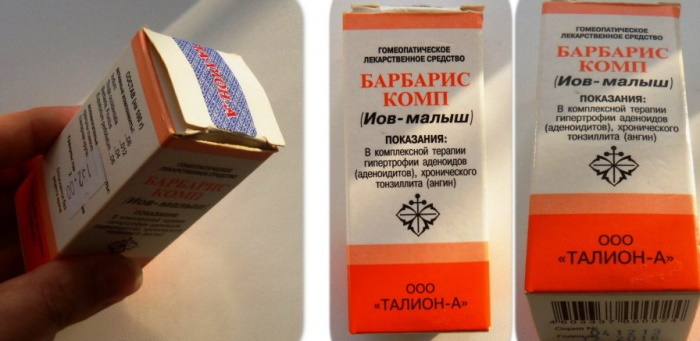Content
- Indications for the installation of a tracheostomy
- Contraindications
- Types of tracheostomy
- Instrumentation for tracheostomy
- Tube types
- Execution technique
- Tracheostomy care
- Consequences, complications
- Tracheostomy videos
The tracheostomy kit is a standard set of instruments that are urgently used to restore the breathing process. Surgical intervention is performed in several ways. If the operation is carried out as planned, then the patient must pass the necessary tests in a timely manner.
Indications for the installation of a tracheostomy
A tracheostomy instrument kit is available in every healthcare facility. Surgery is often performed with sudden respiratory arrest caused by obstruction (including asphyxiation).
Tracheostomy is indicated in the following cases:
- traumatic brain injury, accompanied by respiratory arrest;
- severe intoxication with medicines, alkali, poisons, metal salts;
- a burn of the larynx with acid (including acetic acid), characterized by its narrowing;
- allergic manifestations that have arisen while taking certain medications (including Quincke's edema);
- tumors of the larynx of unexplained etiology;
- measles, whooping cough, diphtheria and other diseases of infectious etiology, characterized by severe inflammation of the respiratory tract;
- swelling of the cartilaginous tissue of the larynx;
- narrowing of the larynx caused by trauma and other mechanical damage;
- ingress of a foreign object into the upper respiratory tract.

Tracheostomy can be performed for pneumonia and myasthenia gravis. Surgeons perform emergency surgery during a heart attack. If the tracheostomy should be planned, for example, with advanced pneumonia, then the patient must undergo an ECG and X-ray, as well as donate blood for hepatitis, syphilis, HIV.
Contraindications
The tracheostomy instrument kit must be sterile. Specialists try not to carry out the operation if the patient has a violation of the functional activity of any vital organ. Tracheostomy is contraindicated in sepsis, acute renal failure and various mental illnesses.
Also, surgical intervention is not performed if access to the larynx is difficult by cervical hemangioma. Compression of the larynx by a goiter or other tumor, kyphoscoliosis, blood disease characterized by its poor coagulability are considered absolute contraindications to tracheostomy.
Types of tracheostomy
The set of instruments for a tracheostomy may vary depending on the type of surgery.
There are several main types of surgical intervention:
- Lower. This method is most often used to stop breathing in children. The incision is located a few centimeters below the thyroid isthmus.
- Average. Surgeons use this method infrequently. The trachea is incised below the thyroid isthmus if access to the upper site is difficult or impossible due to anatomical abnormalities in the development of the trachea and larynx.
-
Upper. This type of surgery is used to stop breathing in adults. The surgeon makes an incision at the top of the trachea above the thyroid isthmus.
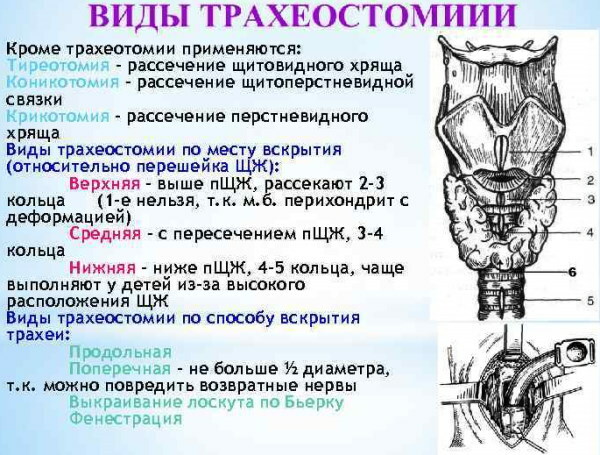
The type of incision can also vary depending on the type of tracheostomy.
Instrumentation for tracheostomy
Intubation equipment should always be sterile. Before the operation, medical personnel on special tables lay out the necessary material that may be needed during the surgical intervention.
The tracheostomy instrument kit includes:
- catheters (several types);
- dilators (including Truss tool);
- cannulas (set of 5);
- sterile syringes;
- cutting needles of different diameters;
- holders for needles;
- curved and straight forceps;
- probes;
- Deschamp needles (left and right);
- fixing hooks;
- surgical scissors (including curved);
- clamps;
- tweezers;
- scalpels.
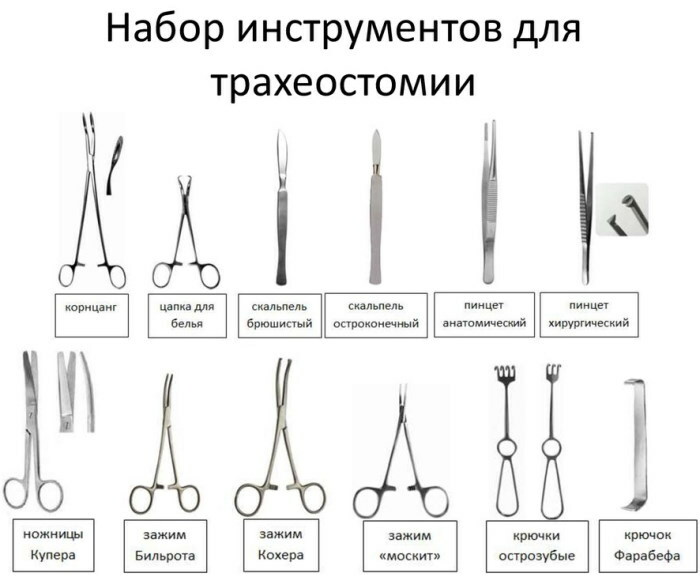
Tracheostomy instruments
Also in the set must be present "clothespins" with which to fix the linen. Gauze dressings are usually sterile. The medical staff places antiseptics and anesthetics on a separate table. Also, the surgeon should have cotton balls on hand.
Tube types
Tracheostomy tubes can be permanent or temporary. The placement of the last type of tracheostomy implies the patient's return to the usual way of life after a certain period of time. Permanent tubes usually have cannulas - a kind of fixation that allows the tracheostomy to be securely anchored inside the opening. Also, the tube can be double and single. Tracheostomy in this category is more convenient to use.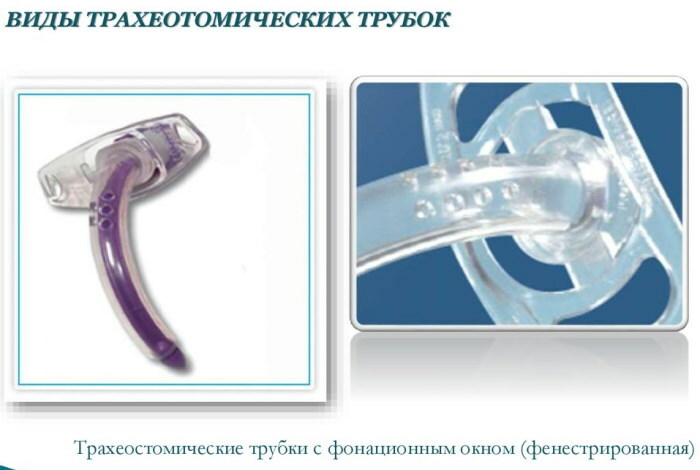
The design consists of two tubes, each of which is equipped with cannulas. Double tracheostomy can be placed before a long trip, especially if it is not possible to regularly clean the inside of the accumulated mucus. One tracheostomy tube can be quickly exchanged for a new one. Double tracheostomy takes some getting used to. Its base is quite wide; at first, a person may experience slight difficulty during inhalation.
Today, there are many tracheostomas on the market, made of soft plastic or silicone. Experts do not recommend purchasing silver-coated tubes - the design is rather inconvenient due to its rigidity.
Cuffed tracheostomies have several advantages. The tubes are equipped with a special bag with air inside. The cuff is inflated independently by pressing the valve. Such tracheostomy is installed immediately after surgery, when the patient is connected to a ventilator.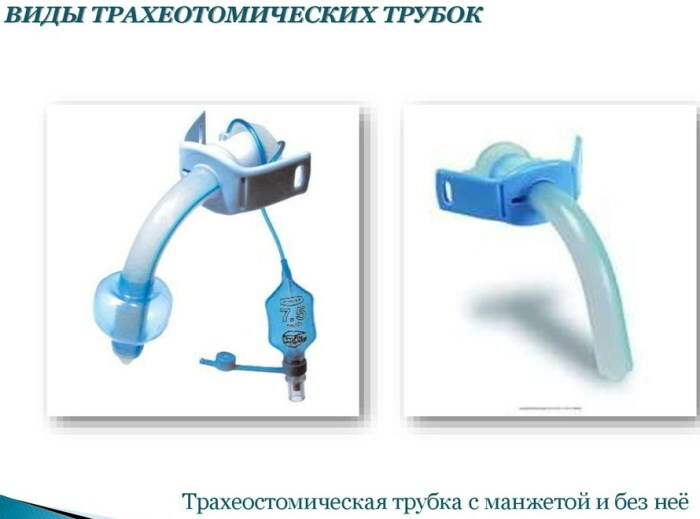
The cuff divides the trachea into equal parts, preventing the upper and lower parts from closing. The air bag will keep food and saliva from entering your lungs. Cuff tracheostomy can be placed in patients arriving in coma.
A cuffless tracheostomy also has several advantages. The tube replaces the cannula. Even with prolonged wearing of a cuffed tracheostomy, the risk of local allergic reactions, manifested by itching, redness, is minimal.
Some types of tracheostomy tubes are equipped with a special aspirator that can be used to quickly remove sputum that has accumulated over the cuff. Connected tubes have a built-in adapter that is usually attached to the inside or outside of the tracheostomy.
The connectors are used to attach a heat and moisture exchanger, various plugs, a voice valve, and ventilator catheters. It is important to choose the correct size of the tracheostomy.
The diameter of the tube is determined by the attending physician:
| The size | Diameter |
| 6 | 13,2 |
| 5 | 12,2 |
| 4 | 11,2 |
| 3 | 10,2 |
| 2 | 9,2 |
| 1 | 8,2 |
| 0 | 7,2 |
| 00 | 6,2 |
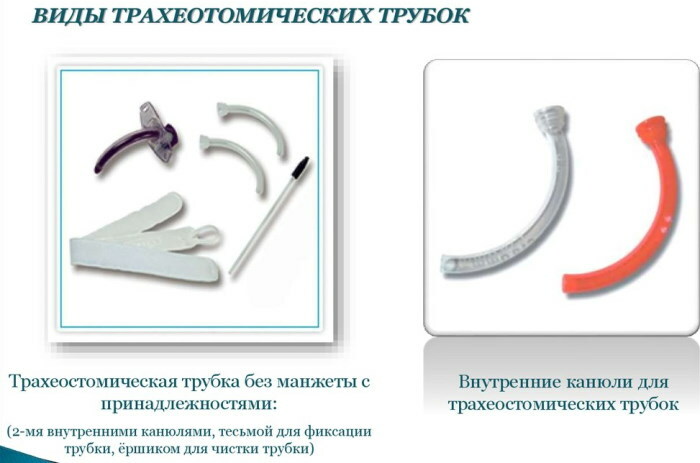 The diameter of the tube is measured with a ruler or caliper.
The diameter of the tube is measured with a ruler or caliper.
Execution technique
The tracheostomy instrument kit should include several types of tubing. A tracheostomy is usually performed under general anesthesia. If surgery is carried out on an emergency basis, then the patient is injected with novocaine and a sedative intravenously.
Tracheostomy cannot be performed without anesthesia - the patient may die from painful shock. The operation in a hospital lasts no more than 40 minutes.
Tracheostomy, regardless of its type, is performed in several stages:
- the patient is placed on a couch, on his back;
- anesthetics are administered;
- incision of the skin and trachea;
- cannulas are inserted and the skin is sutured.
To provide the surgeon with access to the trachea, the patient must be positioned so that his head is slightly tilted back. If tracheostomy needs to be performed in emergency cases for injuries characterized by spinal fractures, then the operation is replaced with standard intubation. The preoperative field is processed by a specialist after the patient falls asleep. The tissue incision can be transverse or longitudinal.
In an upper tracheostomy, the subcutaneous layer and skin are dissected downward from the thyroid cartilage. The size of the cut does not exceed 5 cm. Blunt hooks spread the skin in different directions. The isthmus of the larynx is fixed motionlessly with a sharp hook. Using a scalpel, the surgeon makes an incision in the 4th and 3rd cartilage. After the air enters the lungs from the outside, an expander and a cannula must be inserted into the opening. After suturing the wound, the dilator is removed.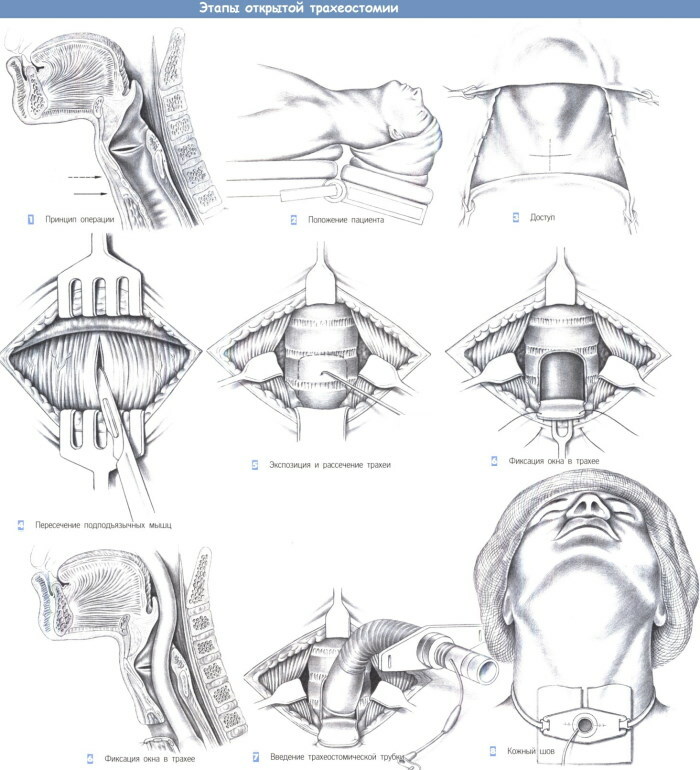
An inferior tracheostomy involves an upward incision. Its length is 6-7 cm. After the surgeon has gained access to the trachea, the skin is incised and the venous jugular arch is retracted downward. The neck muscles are pulled to the sides and the fiber is slightly pushed back. In order to reduce the risk of bleeding, the vessels are compressed. A 4-5 tracheal ring is incised upward. The specialist must make sure that the lining of the larynx and trachea is also opened.
The upper and lower tracheostomy technique differs slightly. The main difference is the direction and size of the notch. The classic tracheostomy has recently been replaced by a percutaneous one. This is due to the high risk of complications and high trauma.
Percutaneous tracheostomy does not need to be performed in a hospital setting. With surgery, the risk of bleeding and infection is minimal. The seams are practically invisible.
Technique:
- the patient lies on the couch, on his back, under the shoulder blades - a roller;
- the puncture site is treated with solutions;
- the incision is carried out horizontally, with the hooks pushing the soft tissues in different directions;
- a puncture needle is inserted between 2-3 or 2-1 rings;
- a guidewire is placed in the needle, a dilator is inserted and a tracheostomy tube is installed;
- after suturing the wound, the retainer is removed.
The tube must be securely fixed. The stoma usually does not form within 3-5 days, so a poorly fixed tracheostomy may fall out.
Tracheostomy care
The tracheostomy set consists of needles, scissors, forceps and hooks. Most of the tools are reusable. After tracheostomy, it is necessary to properly care not only for the skin around the tube, but also for the trachea, nasal and oral completely.
The room where the patient is located should be wet cleaned daily. Dust and other contaminants trapped inside the tracheostomy can provoke an inflammatory process. You cannot use various products with a strong odor. It is advisable to remove books and carpets from the room.
Experts do not recommend spraying air fresheners and other fragrances inside the room. The environment must be non-allergenic. At least 3 times a day, the room is ventilated by opening the windows for 5-10 minutes. even in winter. Indoors, you can install an air ionizer with the permission of the attending physician.
It is important to provide the patient with timely oral and nasal care. The procedures minimize the risk of inflammation and discomfort caused by dry mucous membranes.
It is recommended to brush your teeth at least 2 times a day. If the patient is in a coma, then his lips are periodically moistened with a damp cloth or tampon. You can also use special hygienic moisturizing lipsticks. If the patient is conscious, he can rinse his mouth with dental products that do not contain aggressive components. It is advisable to purchase a liquid without eucalyptus oil.
Special tapes are used to fix the tracheostomy. If they are not at hand, then you can fold the sterile bandage four in length. The tapes are stretched as they become dirty. Experts advise washing the dressings daily. The tape should not press on.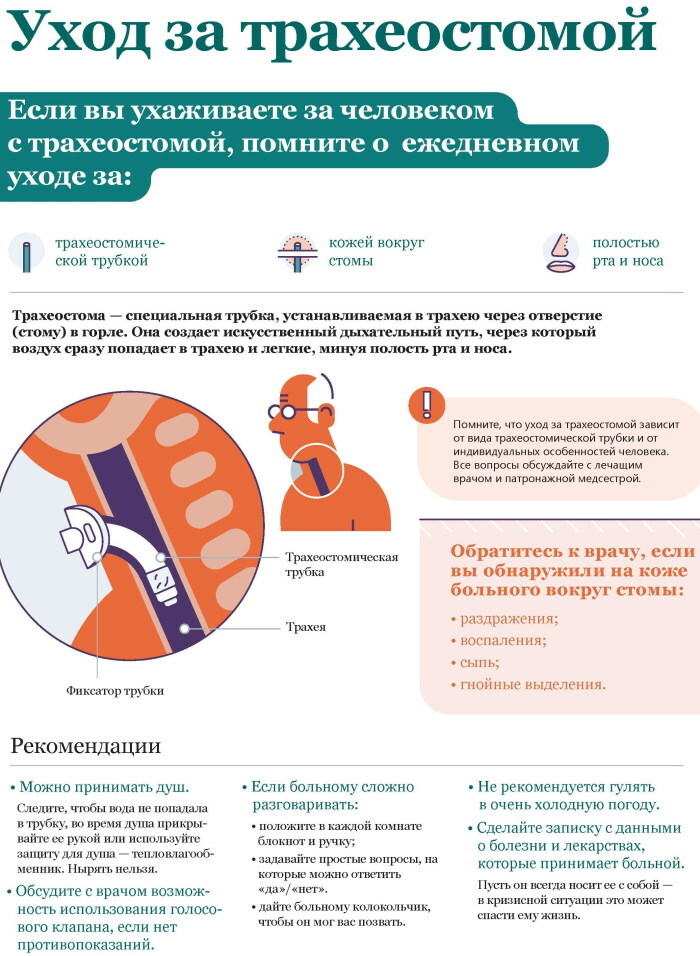
When placing it between the neck and the tape, you need to insert a finger - there should be free space. Sterile wipes should be changed 3 times a day. They are placed around the incision. At each change, the cover must be treated with alcohol-free antiseptics. To prevent the skin from becoming dry, a hypoallergenic baby cream can be applied to the skin of the tube. It is advisable to purchase sterile wipes at a pharmacy.
Experts do not recommend using non-sterile bandages instead of gauze bandages. It is strictly forbidden to use talc and other powders - if fine dust gets into the respiratory tract, then there is a high risk of suffocation. Without a doctor's prescription, you cannot use ointments that contain hormonal substances. If a patient develops a rash, inflammation, redness and irritation around the tracheostomy, consult a doctor
Mucus will regularly collect in the tube, trachea, nose, and mouth after the tube is inserted. It must be removed regularly with a rounded catheter. It should be smaller than the tube itself. The catheter must be inserted along the entire length of the tracheostomy. The procedure is carried out as carefully as possible. If viscous mucus has accumulated inside the tube, then 1-1.5 ml of sodium chloride solution (no more than 0.9%) is poured into the tracheostomy beforehand and only then the sanitation is started.
Dispose of tracheostomies and catheters. Before burning, the product must be placed in any antiseptic solution for 3-4 hours. Catheters need to be changed during debridement. It is impossible to introduce the same device into the oral, nasal cavity and tracheostomy.
Only tubes made of silicone can be reused. Tracheostomas made of soft plastic, especially those with silver plating, must be disposed of immediately after removal.
The cannulated tracheostomy must be cleaned from the inside. During the procedure, you can use saline, a solution of potassium permanganate or furacilin. The crusts formed inside the cannula are cleaned off with a brush. After washing, the tubes are first dried and only then laid out in sealed bags.
To simplify the process of tracheostomy care, experts recommend purchasing an electric pump in advance. The capacity of the aspirator and the hose are sanitized 1-2 times a day. The procedure is best done with gloves. It is advisable to rinse the parts of the aspirator several times with saline. Boiling the parts of the appliance is unacceptable - most of the parts are made of plastic.
The patient should always have at hand:
- spare tracheostomy;
- sputum catheters;
- fixing tapes;
- sterile wipes;
- gauze swabs;
- saline or antiseptic without alcohol;
- electric pump.
Before changing the tracheostomy, you should wash your hands several times with soap and then treat them with a water antiseptic. People who wear a tube all the time should understand that the opening in the trachea should not be allowed to overgrow. The use of any wound-healing ointments is strictly prohibited. Also, experts recommend listening to your own well-being.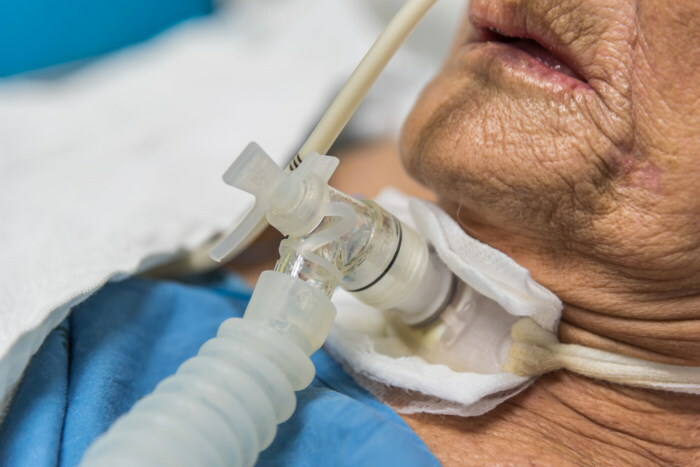
If the patient is worried about burning, itching under the tracheostomy, then you should immediately contact your doctor. Infection of the trachea or soft tissue may be indicated by bloody or purulent discharge. The development of the inflammatory process may be accompanied by the appearance of an unpleasant putrid odor from the wound. Hydrogen peroxide is not used during the refurbishment. It is also forbidden to flush the tracheostomy with this drug.
Consequences, complications
In the absence of adequate care after placement of a tracheostomy, the risk of complications is high. During early rehabilitation after surgery, fistula, emphysema, or bleeding may occur.
If the patient is not promptly sanitized the tube, then tracheitis of an erosive type may develop, accompanied by the formation of crusts covering the lumen of the tracheostomy. Also, complications after surgery include wound infection.
If prolonged pressure is exerted on the walls of the larynx, then the likelihood of developing ischemic necrosis increases. Often, after the placement of a tracheostomy, the patient's voice changes. It becomes quiet and sibilant. This factor is also referred to as complications.
The tracheostomy instrument kit is available only from specialist retailers. Scalpels, hooks should be made of durable stainless steel, expanders - of soft plastic. It is impossible to carry out the operation in the absence of the appropriate skills.
Tracheostomy videos
Tracheostomy:

